Brakes are just one small part of the complex system that is a bike. Every time you close your eyes, picture your bike as this gigantic system of bolts and chains and gears that work together in order to make sure you can arrive at your destination while keeping your body in the best possible shape. Your bike is a mean of transportation that gets you from point A to point B, while pushing you to do so some exercise and give up on driving your car and polluting the environment.
No matter how much we love bikes, there comes a time when parts of it go bonkers and you will be required to change them. Amongst the most important parts of your bike is the braking system, which is just as vital on your bicycle as it is a motor vehicle. There’s no telling what kind of accidents you could get involved in if your bike’s brakes are not reliable. But since you’re no mechanic, how could you possibly know what to look for in a new braking set? No worries, we’ve got your covered!
Table Of Contents
Top 6 Best Bike Brakes Comparisons
Brand | Details |
|---|---|
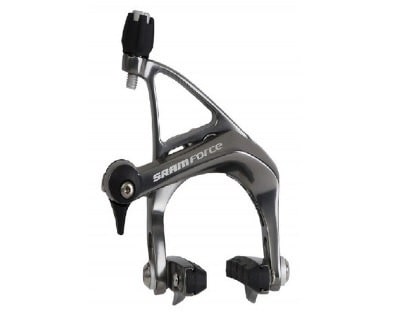 SRAM Force Brake Calipers | |
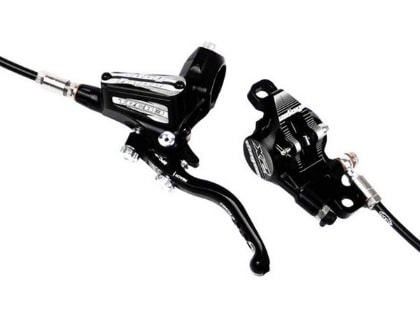 Hope Tech 3 X2 Brake | |
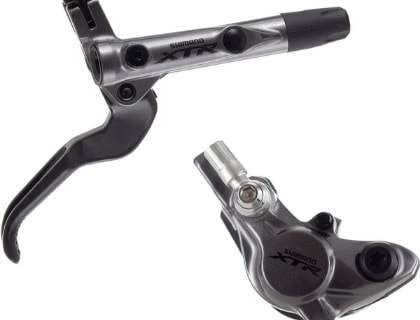 SHIMANO XTR BL-M9000 Race Brakes | |
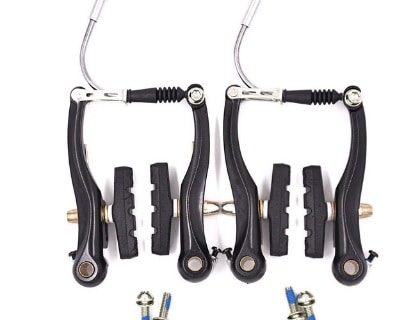 Wake Bike Brakes | |
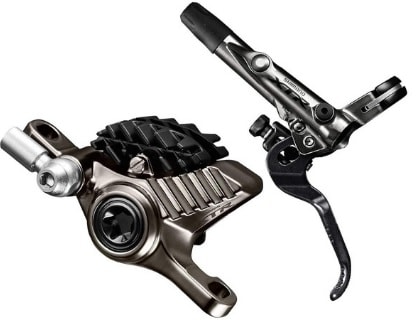 Shimano BR-M9020-Kit Disk Brake Assembled Set | |
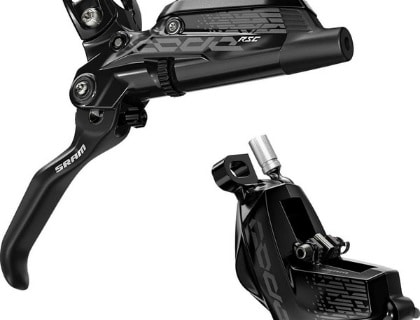 SRAM Code RSC Disc Brake |
Types of Brakes
Pedaling is exciting. It makes you feel alive while allowing you to enjoy the view more than you possibly could if you were driving a car. But bikes are not all sunshine and flowers: they should also function properly in order to make sure that you stay safe no matter the circumstances. There are a lot of bike components that contribute to the safety of the cyclist: from the handlebars mirrors to the blinking tail lights, and even up to the braking system. As a general note, you should know that there are 3 main types of bike brakes to choose from: rim brakes, disc brakes and coaster brakes. Let’s find out what each of them does.
Rim Brakes
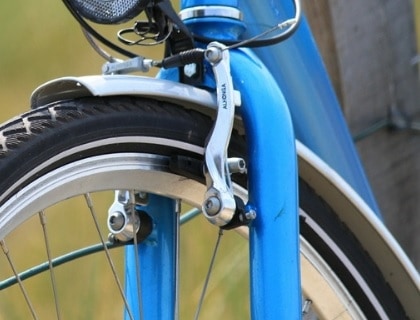
Rim brakes are divided into two other subcategories (you didn’t think this would be easy, did you?): cantilever and v-brakes. Cantilever brakes use a wire that connect the braking lever placed on your handlebar to the pads and the caliper on your bike’s rims. When you apply pressure on the handlebar brakes, the wire tightens and brings the pads and the caliper close to the rim, to slow down the bicycle.
Rim brakes are the oldest systems in the book and, while they are the standard mechanisms that are preferred by a lot of people who don’t care for modern upgrades, they do come with a major disadvantage. Because of how their halting system was conceived, they attract a lot of water and mud directly on the bike’s rim which, in turn, damages the system sooner than it should. This means that every time you ride your bike in muddy and wet conditions, you are contributing to the slow, but sure damage of the components.
There is another type of rim brake which is called a v-brake. If you don’t know your way around bikes, it’s fairly simple to mistake them for cantilever brakes. But a true bike whiz knows that v-brakes have a different anchoring mechanism, keeping the cable away from the wheel’s forks, which means it’s less likely to get in the way while you’re pedaling. V-brakes have become a common choice for people who own mountain bikes and simply cannot afford to take the chance of getting tangled in wires.
Disc Brakes
Our second major category in terms of bike brakes are disc ones. They are probably the best-selling items of their kind, because they provide a lot more advantages compared to rim brakes. How do they function? Well, there is a set of discs placed at the center of your rim that can stop the wheel as they move closer together once you press the level on your bike’s handlebars. So, if bike safety is a concern of yours, these are probably the ones to look at.
The system is often a hydraulic one and it uses a brake fluid that ensures the smoothness of your braking process. As you can imagine, they turn the main disadvantage of v-brakes into an advantage, as the closed mechanisms doesn’t allow any mud to get into the system and this prolongs the lifespan of all the braking components.
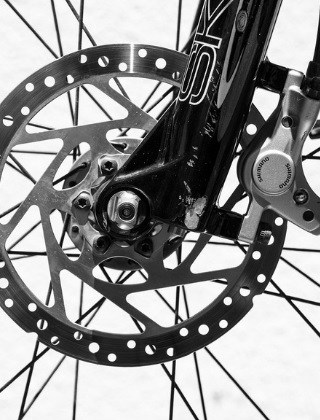
But there is one another important advantage provided by disc brakes. Should the rim get bent in time, the disc brakes won’t be affected. This can often happen when you’re riding on difficult trails, especially if you own a mountain bike and very likely to do so (why else would you buy a mountain bike?).
It’s true that these brakes are noisier compared to other types, but it’s a small price to pay in order to benefit from a truly reliable stopping system. Since they are quite bulky, they aren’t really suitable for road or touring bikes, but they are preferred by MTB owners who are more in need of reliability rather than speed.
Coaster Brakes
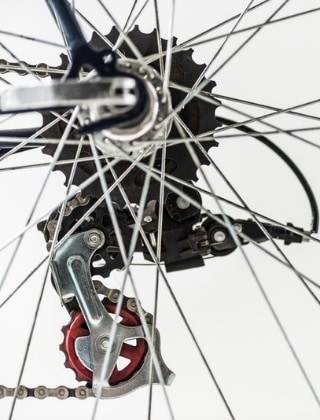
This is the simplest type of braking mechanism that you can possibly find. Due to their simplistic nature, they are mostly found on kid’s bikes. The whole system requires one to simply push backwards on the pedals to activate the brakes. As you can imagine, this simple system does pose a couple of threads. Since it mostly involves bringing the back wheel to a halt, a quick application will eventually lead to losing control of the bike, as it begins to slide.
Since brakes and levers are pretty much a package deal, let’s address a few words about them as well. As you already know, the levers of the brake are mounted on the handlebars, so you can have quick and easy access to them at all times. Standard pull levers are combines with traditional center-pull cantilever or caliper brakes and they are also referred to as short pull levers.
Long pull levers, on the other hand, are compatible with cantilever brakes (v-brakes being the most popular type) and they are very common on mountain bikes. We have to underline the importance of matching your brake lever with the compatible brake type. When these two matches, you will have the right amount of travel and leverage, translated into a good response between the time you press the lever and the actual stop of the bike.
Top 6 Best Bike Brakes Reviews
SRAM Force Brake Calipers

With very good modulation and a decent combination between cold-forged arms and titanium bolts, the SRAM brakes should be pretty good for the average biker. The system comes with a spar that closes the gap between the caliper’s arm and the point where the cable goes inside the brake. This system will make sure that your bike can reach a halt without flexing that causes distraction. The caliper comes with a quick-release mechanism for those who are looking for an easy way to remove the wheel.
Pros
Cons
Hope Tech 3 X2 Brake

First thing’s first: the product in the link is the front brake developed by Hope, but there is also a rear model available if needed. That being said, what makes this brake system so special? You’re going to love the adjustability and high-quality construction of the X2. Their dual piston caliper is oriented towards bikes that are taken on trails or cross-country roads. There are two large dials on the front that will help you adjust both the bite point, as well as the reach. There is a very good balance between the bulkiness and generosity of the construction. But even with its solid construction, the system doesn’t seem to perform all that well in wet and muddy conditions. There are some organic pads located within the caliper.
Pros
Cons
SHIMANO XTR BL-M9000 Race Brakes

It is no secret that Shimano delivers some of the best bike brake systems in the world. With a lever made from carbon fiber that feels both durable and pleasant to the touch, Shimano has paid attention to all the small details that form a product as good as this brake. So, what can you expect from this particular braking set?
Thanks to the insulated glass fiber piston that’s combines with a nice insulated pad coating, you can rest assured that heat won’t be a problem for this system. Heat control really is taken to the next level. Another feature that’s important for cyclist that are looking to lose some extra weight is the fact that the Shimano system doesn’t add that much on your bike. That’s because the components of the braking system use a combination of carbon with a magnesium caliper.
Pros
Cons
Wake Bike Brakes

As we mentioned in the beginning of the article, v-brakes aren’t exactly a modern and very reliable choice. They are, however, preferred by veteran cyclist, who like to ride old-school on a mechanism they’ve known and understood since forever. These v-brakes are made from a combination of plastic and aluminum alloy which, surprisingly enough, doesn’t make them as light as you think. The set comes with its very own included brake pads. Due to their simplicity, the brakes are also easy to install, with a strong set of springs that allow a good level of adjustment.
Pros
Cons
Shimano BR-M9020-Kit Disk Brake Assembled Set

The M9020 is giving us a lot to talk about and, as the price tag has probably suggested already, you’ll be paying a lot of money for one of the best endurance brakes we’ve ever seen. Thanks to the integrated Servo Wave technology, you have great braking power with a slight press of the lever. But let’s start at the beginning. Every brake system developed by Shimano has always been easy to install, provided you’ve previously held a screwdriver before.
There is a difference between the mounting of the front and back brakes. The front calipers are mounted with normal Shimano bolts, while the back ones have a particular set of lightweight ones. Shimano has a bleed kit that makes the process a lot easier.
But what about the performance of these brakes? We have to admit, they do provide a great balance between the performance and the lightweight of the system. However, there is a noticeable difference between the performance of the front brake and the one placed at the rear. The level firmness feels a bit limited due to the lightweight design of its housing.
Another downside would be the not-so-generous housing of the reservoirs that allow a low volume of fluid to be added. As mentioned, the rear brake lever feels a bit stiffer and doesn’t provide good modulation, problem that could be fixable by a more generous amount of fluid. The good news is that you will most likely rely on the power of the front brake and no so much on the rear one. Overall, the M9020 is still one of the best kits we’ve ever seen.
Pros
Cons
SRAM Code RSC Disc Brake

A lot of you may have already heard that 2% of the world’s population holds 98% of the fortune. Things seems to be pretty similar on the bike brake market, since there are about 4 major players that sell 96% of the best bike braking systems. And SRAM is no exception, considering that yet another one of the braking systems has found its way into this review. There are lots of things you’re going to appreciate about this system.
The heat dissipation capability is one of them. Second, the modulation. In fact, the Code R performs so well at this chapter, it can even help you face winter’s wrath by making sure wet rocks and frozen mud won’t get in the way of your braking system working at optimal performance. Another thing you can’t complain about is the durability. No wonder these brakes cost so much.
Pros
Cons
The Bottom Line
The main thing that you have to remember after having read this round up is that there is no perfect type of bike brake. It all depends on the type of bike you own and the trails and roads that you face. As you can imagine, a braking system that’s suited for a kid’s bike won’t be that fruitful when installed on an adult one. Of course, some of you may still be puzzled in knowing which brakes are most suitable for which bikes, so let’s try and come to a conclusion together.
Your riding style and habits are super important in determining the best bike brakes for your needs. Do you use the same bike for every season? Because if you own one that you specifically ride during spring and summer days, you can opt for a set of rim brakes, provided you won’t come in contact with water too much. We’ve already established that rim brakes aren’t all that solid when it comes to facing mud, so if you want to prolong your bike’s lifespan, don’t go wet and rim. But if you are a novice cyclist, you might want to opt for rim brakes simply because they are cheaper and therefore easier to replace. It’s just until you get the hang of things, I promise.
However, if you have a bike that’s with you the entire year, you need something that can handle dirtier days, so a disc brake is a much better option. This way, you will have consistent braking no matter what Mother Nature has in store for you.

